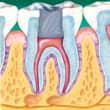Overview
Root canal is a treatment to repair and save a badly damaged or infected tooth instead of removing it. The procedure involves removing the damaged area of the tooth (the pulp) and cleaning and disinfecting it, then filling and sealing it. The common causes affecting the pulp are a cracked tooth, a deep cavity, repeated dental treatment to the tooth or trauma to it. The term "root canal" comes from cleaning of the canals inside the tooth's root.
Decades ago, root canal treatments were painful. With dental advances and local anesthetics, most people have little if any pain with a root canal today.
Understanding
Root canal treatment consists of a number of steps that take place over several office visits, depending on the situation. These steps are:
The endodontist examines and x-rays the tooth, then local anesthesia is administered to the affected tooth.
A dental dam is usually placed over the affected tooth to isolate it and keep it free from saliva.
The endodontist makes an opening through the back of a front tooth or the crown of a molar or pre-molar to remove the diseased pulp, called a pulpectomy.
Next, the pulp chamber and root canals are cleaned and shaped in preparation for a filling.
The endodontist fills the root canal with gutta percha material.
If more than one visit is needed, a temporary filling is placed in the crown opening to protect the tooth between dental visits. The temporary filling is removed and the pulp chamber and root canal are permanently filled with gutta percha into each of the canals and is sealed in place with cement. Sometimes a metal or plastic rod is placed in the canal for structural support. In the final step, a crown is usually placed over the tooth to restore its natural shape and appearance. If the tooth is broken, a post may be required to build it up prior to placing a crown.
Planning
Many people worry that a root canal will be painful, something that was true in the past. Today, with advanced anesthesia options and surgical techniques - a root canal is as comfortable as getting a filling. An infected tooth (pre-root canal), is usually what causes tooth pain, and a root canal is the solution to this problem. In fact, infected tooth pulp can cause a tooth abscess and can destroy the bone surrounding the tooth.
A treated and restored tooth can last a lifetime with proper care. Root canals have a high success rate and are significantly less expensive than the alternative, tooth extraction and replacement with a bridge or implant.
But tooth decay can still occur in treated teeth, so good oral hygiene and regular dental exams are necessary to prevent further problems.
To determine the success or failure of root canal treatment, dentists typically compare new X-rays with those taken prior to treatment. This comparison will show whether bone continues to be lost or is being regenerated.
Sometimes root canals are not successful because an infection develops inside the tooth, or the original infection was not fully removed. In these cases, an apicoectomy, a procedure where the infection and the root tip are removed and a filling placed, is done. Other times a second root canal is recommended.
What is a Root Canal?
Root canal treatment is the removal of the tooth's pulp, a small, thread-like tissue in the center of the tooth. Once the damaged, diseased or dead pulp is removed, the remaining space is cleaned, shaped and filled. This procedure seals off the root canal. Years ago, teeth with diseased or injured pulps were removed. Today, root canal treatment saves many teeth that would otherwise be lost.
The most common causes of pulp damage or death are:
A cracked tooth
A deep cavity
An injury to a tooth, such as a severe knock to the tooth, either recent or in the past
Once the pulp is infected or dead, if left untreated, pus can build up at the root tip in the jawbone, forming an abscess. An abscess can destroy the bone surrounding the tooth and cause pain
How is a Root Canal Done?
Root canal treatment consists of several steps that take place over several office visits, depending on the situation. These steps are:
First, an opening is made through the back of a front tooth or the crown of a molar or pre-molar.
After the diseased pulp is removed (a pulpectomy), the pulp chamber and root canals are cleaned, enlarged and shaped in preparation for being filled.
If more than one visit is needed, a temporary filling is placed in the crown opening to protect the tooth between dental visits.
The temporary filling is removed and the pulp chamber and root canal permanently filled. A tapered, rubbery material called gutta-percha is inserted into each of the canals and is often sealed into place with cement. Sometimes a metal or plastic rod is placed in the canal for structural support.
In the final step, a crown is usually placed over the tooth to restore its natural shape and appearance. If the tooth is very broken down, a post may be required to build it up prior to placing a crown.
How Long Will the Restored Tooth Last?
Your treated and restored tooth/teeth can last a lifetime with proper care. Because tooth decay can still occur in treated teeth, good oral hygiene and regular dental exams are necessary to prevent further problems.
As there is no longer a pulp keeping the tooth alive, root-treated teeth can become brittle and are more prone to fracture. This is an important consideration when deciding whether to crown or fill a tooth after root canal treatment.
To determine the success or failure of root canal treatment, the most relied-upon method is to compare new X-rays with those taken prior to treatment. This comparison will show whether bone continues to be lost or is being regenerated.



Tooth pulp damaged by a deep cavity.
The pulp is removed and the root canals cleaned before filling.
The chamber is filled and sealed.


No comments:
Post a Comment